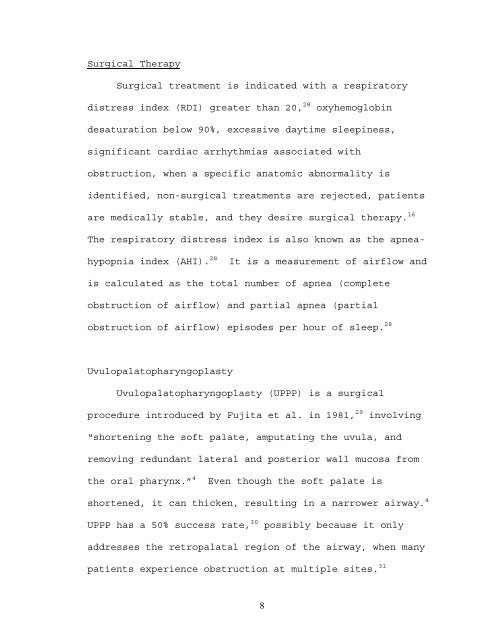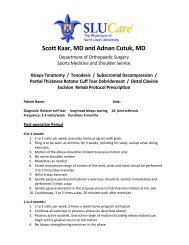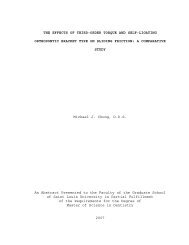PHARYNGEAL AIRWAY VOLUME FOLLOWING ...
PHARYNGEAL AIRWAY VOLUME FOLLOWING ...
PHARYNGEAL AIRWAY VOLUME FOLLOWING ...
Create successful ePaper yourself
Turn your PDF publications into a flip-book with our unique Google optimized e-Paper software.
Surgical Therapy<br />
Surgical treatment is indicated with a respiratory<br />
distress index (RDI) greater than 20, 28 oxyhemoglobin<br />
desaturation below 90%, excessive daytime sleepiness,<br />
significant cardiac arrhythmias associated with<br />
obstruction, when a specific anatomic abnormality is<br />
identified, non-surgical treatments are rejected, patients<br />
are medically stable, and they desire surgical therapy. 16<br />
The respiratory distress index is also known as the apnea-<br />
hypopnia index (AHI). 28 It is a measurement of airflow and<br />
is calculated as the total number of apnea (complete<br />
obstruction of airflow) and partial apnea (partial<br />
obstruction of airflow) episodes per hour of sleep. 28<br />
Uvulopalatopharyngoplasty<br />
Uvulopalatopharyngoplasty (UPPP) is a surgical<br />
procedure introduced by Fujita et al. in 1981, 29 involving<br />
“shortening the soft palate, amputating the uvula, and<br />
removing redundant lateral and posterior wall mucosa from<br />
the oral pharynx.” 4 Even though the soft palate is<br />
shortened, it can thicken, resulting in a narrower airway. 4<br />
UPPP has a 50% success rate, 30 possibly because it only<br />
addresses the retropalatal region of the airway, when many<br />
patients experience obstruction at multiple sites. 31<br />
8

















